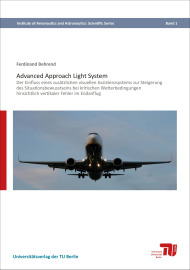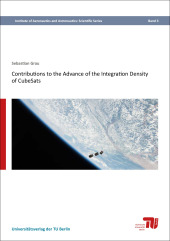Advanced Approach Light System
Der Einfluss eines zusätzlichen visuellen Assistenzsystems zur Steigerung des Situationsbewusstseins bei kritischen Wetterbedingungen hinsichtlich vertikaler Fehler im Endanflug

Format: 14,8 x 21,0 cm
Publishing year: 2017
The constant growth in aviation requires the introduction of new technologies, in order to meet the demand for increasing capacity. Especially the airport often represents the limiting factor. Poor visibility conditions and an insufficiently equipped ground infrastructure, regarding navigation facilities, can lead to restrictions in maintaining the prevailing traffic flow – especially during the approaches. The conventional instrument landing system consists of numerous technical components, which are causing expenses regarding maintenance and operation. Smaller airports are often only partially or not at all equipped with the appropriate ground facilities. This can bring air traffic to a total halt during certain visibility conditions. New satellite-based approach procedures offer the possibility to keep up air traffic even during poor visibility conditions, regardless of the ground infrastructure required in the past. These also offer now a barometric guidance or an augmented satellite signal for the vertical flight guidance component. With the use of these approach procedures there is however the possibility of new faults and errors of the vertical flight guidance signal. In a system based on electromagnetic radio waves a fault is angular, meaning if the airplane gets nearer to the transmitter on ground the absolute possible failure of the target approach path gets smaller. In a satellite based approach, on the other hand, it is constant during the whole approach. The result can be a great deviation from the target approach path even just before reaching the runway threshold. Often only after reaching the decision height and the herewith connected visual contact to corresponding ground features, these faults can be recognized during poor visibility conditions close to the minima of a precision approach flight. The larger the absolute error to the target approach path, the more crucial it gets to initate a missed approach procedure and therefore preventing a drop out of the relevant obstacle clearance limit. Research has shown that through the currently present visual characteristics of the approach lighting system the actual position cannot be determined sufficiently regarding the runway threshold and the target approach path in order to estimate the decision height correctly. The here presented “Advanced Approach Light System” is supposed to be an additional visual aid in order to support the cockpit crew in its decisions. Therefore it should amount to improve the awareness of the situation regarding constant vertical faults. The new navigation lighting system has been integrated into a flight simulator and was tested by licensed airline pilots within two test series with varying visibility conditions and decision heights. Next to basic functionality operational usability in existing procedures of practical routines in the cockpit has been evaluated. The results of the test series have demonstrated a significant improvement in identifying vertical faults with the support of the “Advanced Approach Light System”. The decision to initiate a missed approach was made immediate and prompt and therefore the airplane stayed within the obstacle clearance limit even in a low decision height. In contrast, the trial participants without the new system took reluctant and often far too late decisions, which lead to a drop out of the obstacle clearance limit. The “Advanced Approach Lighting System” has significantly improved the situation awareness for pilots in command in recognizing vertical faults when reaching the decision height. The integration in existing work routines and its operative use happened flawlessly and was highly accepted by the trial participants.



